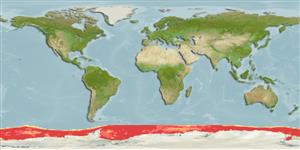Actinopterygii (peixes com raios nas barbatanas) >
Perciformes (Perch-likes) >
Nototheniidae (Cod icefishes)
Etymology: Pleuragramma: Greek, pleura = side, ribe + Greek, gramma = letter, signal (Ref. 45335); antarctica: Named after the region in which this is common (Ref. 11892).
Ambiente / Clima / Intervalo
Ecologia
; marinhas; intervalo de profundidade 0 - 728 m (Ref. 11892). Polar; ? - 2°C (Ref. 6390), preferred -2°C (Ref. 107945); 60°S - 78°S
Southern Ocean: Antarctic Peninsula, South Shetland, Elephant, South Orkney islands, Weddell, Bellingshausen, Ross and Davis seas, Oates, Adélie, Wilhelm and other coasts of East Antarctica to Prydz Bay.
Length at first maturity / Tamanho / Peso / Idade
Maturity: Lm ?, range 13 - ? cm
Max length : 25.0 cm TL macho/indeterminado; (Ref. 5179); common length : 15.0 cm TL macho/indeterminado; (Ref. 2121); Peso máx. publicado: 200.00 g (Ref. 6390); Idade máx. registada: 20 anos (Ref. 5216)
Espinhos dorsais (total): 6 - 8; Raios dorsais moles (total): 35-38; Espinhos anais 0; Raios anais moles: 36 - 39; Vértebras: 52 - 56. Pre-opercular-mandibular canal pores 9 (rarely 10), with 3 (rarely 4) on the mandible. Infraorbital canal with 4+2 pores; lateral line organs (neuromasts) present exposed region between the canal segments, the normal number probably being 4 (rarely 5), but some or all are often missing. Supraorbital canal with 3+1 pores (a second, more posterior pore rarely present in postero-dorsal section); between these 2 supraorbital canal segments is a trough divided by 3 low transverse ridges into 4 shallow depressions; on each ridge is a neuromasts organ. Temporal canal with 1+4 pores; between the 2 segment lies a single exposed neuromast. Supratemporal canal with 1+1 pores; no traces of neuromasts were found in the intervening regions.
Color: In life, pink with a silvery hue, the dorsal surface slightly darker. All fins pale, with clear hyaline membranes. The body becomes silvery with a darker dorsum only after death (Ref. 28937).
Regarded as the only truly pelagic fish in Antarctic waters (Ref. 6390). Larvae and postlarvae occur between 0 to 135 m; juveniles 50 to 400 and adults below 400 m (Ref. 5179). Postlarvae feed mainly on eggs and larvae of copepods; juveniles mainly on copepods, but take also eggs and larvae of euphausiids, polychaetes and chaetognaths (Ref. 5179). Larger items are ingested with increase in size (Ref. 5179). Larval pelagic phase is long (Ref. 28916).
Mature females may spawn for the first time from around 7-9 years of age (Ref. 71843).
Dewitt, H.H., P.C. Heemstra and O. Gon, 1990. Nototheniidae. p. 279-331. In O. Gon and P.C. Heemstra (eds.) Fishes of the Southern Ocean. J.L.B. Smith Institute of Ichthyology, Grahamstown, South Africa. (Ref. 5179)
Categoria na Lista Vermelha da IUCN (Ref. 115185)
CITES (Ref. 94142)
Not Evaluated
Ameaça para o homem
Harmless
Utilização humana
Pescarias: pouco comercial
Mais informação
ColaboradoresFotografiasStamps, CoinsSonsCiguateraVelocidadeTipo de nataçãoÁrea branquialOutras referênciasCérebrosVisão
Ferramentas
Relatórios especiais
Descarregue XML
Fontes da internet
Estimates of some properties based on models
Phylogenetic diversity index (Ref.
82805): PD
50 = 1.0000 [Uniqueness, from 0.5 = low to 2.0 = high].
Bayesian length-weight: a=0.00575 (0.00309 - 0.01073), b=3.18 (3.01 - 3.35), in cm Total Length, based on LWR estimates for this species & (Sub)family-body (Ref.
93245).
Nível Trófico (Ref.
69278): 3.2 ±0.3 se; Based on diet studies.
Resiliência (Ref.
69278): Baixo, tempo mínimo de duplicação da população 4,5 - 14 anos (K=0.14; tm=3-4; tmax=20; Fec=4,000).
Prior r = 0.41, 2 SD range = 0.21 - 0.80, log(r) = -0.89, SD log(r) = 0.34, Based on: 1 K, 2 tgen, 1 tmax, 2 Fec records
Vulnerabilidade (Ref.
59153): Moderate to high vulnerability (52 of 100) .
